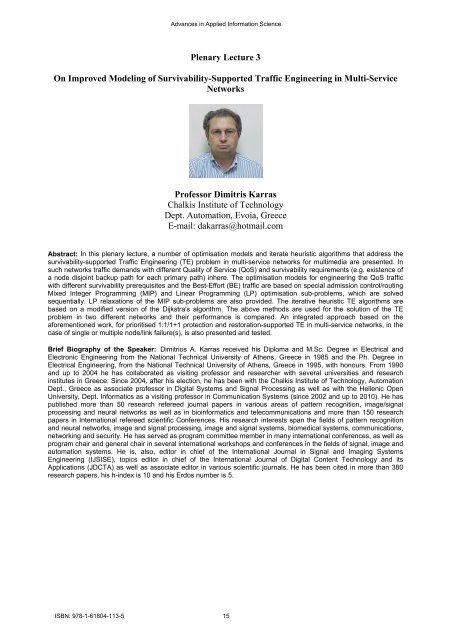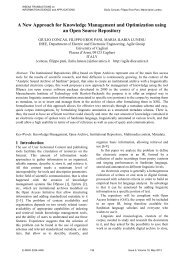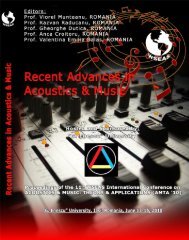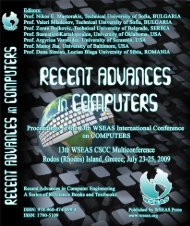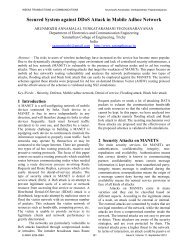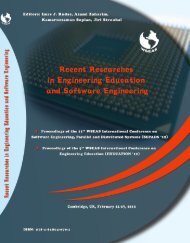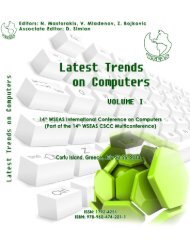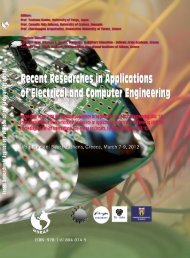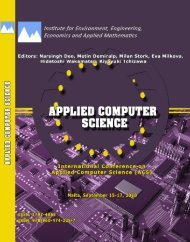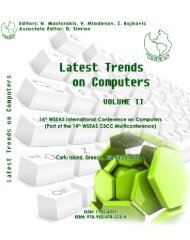ADVANCES in APPLIED INFORMATION SCIENCE - WSEAS
ADVANCES in APPLIED INFORMATION SCIENCE - WSEAS
ADVANCES in APPLIED INFORMATION SCIENCE - WSEAS
Create successful ePaper yourself
Turn your PDF publications into a flip-book with our unique Google optimized e-Paper software.
Advances <strong>in</strong> Applied Information SciencePlenary Lecture 3On Improved Model<strong>in</strong>g of Survivability-Supported Traffic Eng<strong>in</strong>eer<strong>in</strong>g <strong>in</strong> Multi-ServiceNetworksProfessor Dimitris KarrasChalkis Institute of TechnologyDept. Automation, Evoia, GreeceE-mail: dakarras@hotmail.comAbstract: In this plenary lecture, a number of optimisation models and iterate heuristic algorithms that address thesurvivability-supported Traffic Eng<strong>in</strong>eer<strong>in</strong>g (TE) problem <strong>in</strong> multi-service networks for multimedia are presented. Insuch networks traffic demands with different Quality of Service (QoS) and survivability requirements (e.g. existence ofa node disjo<strong>in</strong>t backup path for each primary path) <strong>in</strong>here. The optimisation models for eng<strong>in</strong>eer<strong>in</strong>g the QoS trafficwith different survivability prerequisites and the Best-Effort (BE) traffic are based on special admission control/rout<strong>in</strong>gMixed Integer Programm<strong>in</strong>g (MIP) and L<strong>in</strong>ear Programm<strong>in</strong>g (LP) optimisation sub-problems, which are solvedsequentially. LP relaxations of the MIP sub-problems are also provided. The iterative heuristic TE algorithms arebased on a modified version of the Dijkstra's algorithm. The above methods are used for the solution of the TEproblem <strong>in</strong> two different networks and their performance is compared. An <strong>in</strong>tegrated approach based on theaforementioned work, for prioritised 1:1/1+1 protection and restoration-supported TE <strong>in</strong> multi-service networks, <strong>in</strong> thecase of s<strong>in</strong>gle or multiple node/l<strong>in</strong>k failure(s), is also presented and tested.Brief Biography of the Speaker: Dimitrios A. Karras received his Diploma and M.Sc. Degree <strong>in</strong> Electrical andElectronic Eng<strong>in</strong>eer<strong>in</strong>g from the National Technical University of Athens, Greece <strong>in</strong> 1985 and the Ph. Degree <strong>in</strong>Electrical Eng<strong>in</strong>eer<strong>in</strong>g, from the National Technical University of Athens, Greece <strong>in</strong> 1995, with honours. From 1990and up to 2004 he has collaborated as visit<strong>in</strong>g professor and researcher with several universities and research<strong>in</strong>stitutes <strong>in</strong> Greece. S<strong>in</strong>ce 2004, after his election, he has been with the Chalkis Institute of Technology, AutomationDept., Greece as associate professor <strong>in</strong> Digital Systems and Signal Process<strong>in</strong>g as well as with the Hellenic OpenUniversity, Dept. Informatics as a visit<strong>in</strong>g professor <strong>in</strong> Communication Systems (s<strong>in</strong>ce 2002 and up to 2010). He haspublished more than 50 research refereed journal papers <strong>in</strong> various areas of pattern recognition, image/signalprocess<strong>in</strong>g and neural networks as well as <strong>in</strong> bio<strong>in</strong>formatics and telecommunications and more than 150 researchpapers <strong>in</strong> International refereed scientific Conferences. His research <strong>in</strong>terests span the fields of pattern recognitionand neural networks, image and signal process<strong>in</strong>g, image and signal systems, biomedical systems, communications,network<strong>in</strong>g and security. He has served as program committee member <strong>in</strong> many <strong>in</strong>ternational conferences, as well asprogram chair and general chair <strong>in</strong> several <strong>in</strong>ternational workshops and conferences <strong>in</strong> the fields of signal, image andautomation systems. He is, also, editor <strong>in</strong> chief of the International Journal <strong>in</strong> Signal and Imag<strong>in</strong>g SystemsEng<strong>in</strong>eer<strong>in</strong>g (IJSISE), topics editor <strong>in</strong> chief of the International Journal of Digital Content Technology and itsApplications (JDCTA) as well as associate editor <strong>in</strong> various scientific journals. He has been cited <strong>in</strong> more than 380research papers, his h-<strong>in</strong>dex is 10 and his Erdos number is 5.ISBN: 978-1-61804-113-5 15


